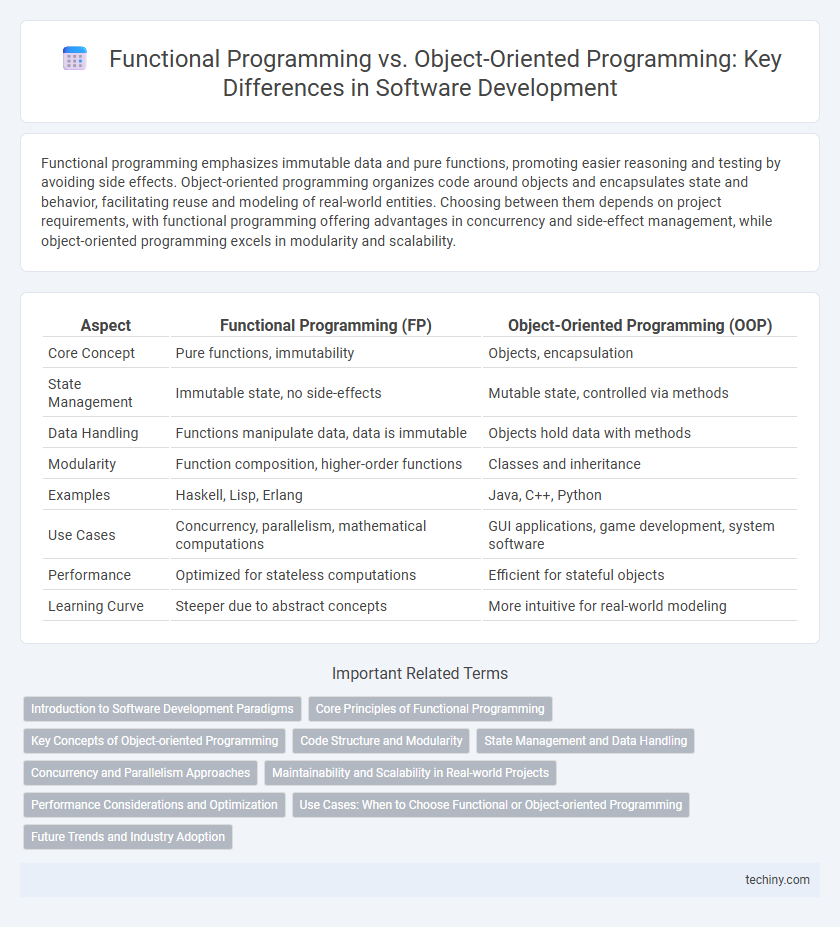Functional programming emphasizes immutable data and pure functions, promoting easier reasoning and testing by avoiding side effects. Object-oriented programming organizes code around objects and encapsulates state and behavior, facilitating reuse and modeling of real-world entities. Choosing between them depends on project requirements, with functional programming offering advantages in concurrency and side-effect management, while object-oriented programming excels in modularity and scalability.
Table of Comparison
| Aspect | Functional Programming (FP) | Object-Oriented Programming (OOP) |
|---|---|---|
| Core Concept | Pure functions, immutability | Objects, encapsulation |
| State Management | Immutable state, no side-effects | Mutable state, controlled via methods |
| Data Handling | Functions manipulate data, data is immutable | Objects hold data with methods |
| Modularity | Function composition, higher-order functions | Classes and inheritance |
| Examples | Haskell, Lisp, Erlang | Java, C++, Python |
| Use Cases | Concurrency, parallelism, mathematical computations | GUI applications, game development, system software |
| Performance | Optimized for stateless computations | Efficient for stateful objects |
| Learning Curve | Steeper due to abstract concepts | More intuitive for real-world modeling |
Introduction to Software Development Paradigms
Functional programming emphasizes immutable data and pure functions, promoting predictable and testable code by avoiding side effects. Object-oriented programming models software design using objects that encapsulate state and behavior, facilitating code reuse through inheritance and polymorphism. Both paradigms offer distinct approaches to software development, influencing maintainability, scalability, and debugging strategies.
Core Principles of Functional Programming
Functional programming centers on pure functions, immutability, and first-class functions, enabling predictable and side-effect-free code. It emphasizes declarative programming paradigms, where expressions are evaluated rather than commands executed, promoting easier reasoning and refactoring. Higher-order functions and recursion replace loops and mutable states common in object-oriented programming, enhancing modularity and concurrency handling.
Key Concepts of Object-oriented Programming
Object-oriented programming (OOP) centers around key concepts such as encapsulation, inheritance, polymorphism, and abstraction, which organize code into reusable objects that model real-world entities. Encapsulation ensures data hiding by bundling data and methods within classes, while inheritance allows new classes to derive properties and behaviors from existing ones, promoting code reuse. Polymorphism enables objects to be treated as instances of their parent class, allowing for dynamic method overriding and flexible interface implementation.
Code Structure and Modularity
Functional programming emphasizes immutability and pure functions, leading to highly modular and reusable code components that minimize side effects. Object-oriented programming structures code around objects and classes, encapsulating data and behavior to promote code organization and inheritance. Both paradigms enhance modularity but differ in approach: functional programming relies on function composition, while object-oriented programming leverages class hierarchies and polymorphism.
State Management and Data Handling
Functional Programming emphasizes immutable state and pure functions, enhancing predictability and reducing side effects in state management. Object-oriented Programming relies on mutable objects and encapsulation, allowing state to be modified through methods that manipulate object data. Data handling in Functional Programming leverages higher-order functions and recursion for transformation, while Object-oriented Programming uses methods and inheritance to structure and manipulate data.
Concurrency and Parallelism Approaches
Functional programming excels in concurrency and parallelism by leveraging immutable data structures and pure functions, which eliminate side effects and enable safe, predictable execution across multiple threads. Object-oriented programming relies on encapsulation and mutable state managed through synchronization mechanisms like locks or monitors to handle concurrent processes, often introducing complexity and potential for race conditions. Functional paradigms inherently support parallel execution by allowing tasks to run independently without shared state, whereas object-oriented approaches require careful coordination to avoid conflicts and ensure thread safety.
Maintainability and Scalability in Real-world Projects
Functional programming enhances maintainability by promoting immutability and pure functions, reducing side effects and simplifying debugging. Object-oriented programming supports scalability through encapsulation and inheritance, enabling modular codebases that can grow with project complexity. Real-world projects benefit from combining functional paradigms for predictable state management and object-oriented designs for flexible system architecture.
Performance Considerations and Optimization
Functional Programming often enables easier parallelization and immutability, which can lead to safer concurrent execution and better performance in multi-core environments. Object-oriented Programming typically offers more straightforward state management and can benefit from method inlining and polymorphism optimizations in modern compilers. Performance optimization in functional code focuses on reducing recursion overhead and leveraging lazy evaluation, while OOP optimization emphasizes efficient memory use and minimizing dynamic dispatch costs.
Use Cases: When to Choose Functional or Object-oriented Programming
Functional programming excels in data transformation, parallel processing, and stateless computations, making it ideal for applications requiring high concurrency and immutability. Object-oriented programming offers advantages in complex systems with hierarchical relationships and mutable states, such as GUI applications and game development. Choosing between them depends on factors like project requirements, team expertise, and the need for maintainability or scalability.
Future Trends and Industry Adoption
Functional programming is gaining traction due to its advantages in handling concurrent and parallel processing, making it ideal for scalable cloud-native applications and big data analytics. Object-oriented programming remains dominant in legacy systems and enterprise software, but industries are increasingly adopting hybrid models that integrate functional paradigms for improved modularity and maintainability. Emerging trends highlight the rise of multi-paradigm languages like Scala and Kotlin, driving broader acceptance of functional programming concepts within traditional object-oriented environments.
Functional Programming vs Object-oriented Programming Infographic

 techiny.com
techiny.com